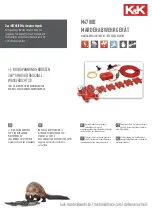
LEXI-R422 - System integration manual
UBX-23007449 - R02
Design-in
Page 53 of 108
C1-Public
•
External antennas (e.g. linear monopole):
o
External antennas basically do not imply physical restriction to the design of the PCB where
the LEXI-R422 module is mounted.
o
The radiation performance mainly depends on the antennas: it is required to select antennas
with optimal radiating performance in the operating bands.
o
RF cables should be carefully selected to have minimum insertion losses: additional insertion
loss will be introduced by low quality or long cable; large insertion loss reduces both transmit
and receive radiation performance.
o
A high quality 50
RF connector provides a clean PCB-to-RF-cable transition: it is
recommended to strictly follow the layout and cable termination guidelines provided by the
connector manufacturer.
•
Integrated antennas (e.g. PCB antennas such as patches or ceramic SMT elements):
o
Internal integrated antennas imply physical restriction to the design of the PCB: integrated
antenna excites RF currents on its counterpoise, typically the PCB ground plane of the device
that becomes part of the antenna; its dimension defines the minimum frequency that can be
radiated. Therefore, the ground plane can be reduced down to a minimum size that should be
similar to the quarter of the wavelength of the minimum frequency that needs to be radiated,
given that the orientation of the ground plane relative to the antenna element must be
considered. As numerical example, the PCB physical restriction can be considered as following:
Frequency = 750 MHz
→
Wavelength = 40 cm
→
Minimum GND plane size = 10 cm
o
Radiation performance depends on the whole PCB and antenna system design, including
product mechanical design and usage: antennas should be selected with optimal radiating
performance according to the mechanical specifications of the PCB and the whole product.
o
It is recommended to select a custom antenna designed by an antennas manufacturer if the
required ground plane dimensions are very small (e.g. less than 6.5 cm long and 4 cm wide); the
antenna design process should begin at the start of the whole product design process.
o
It is highly recommended to strictly follow the detailed and specific guidelines provided by the
antenna manufacturer regarding correct installation and deployment of the antenna system,
including PCB layout and matching circuitry.
o
Further to the custom PCB and product restrictions, antennas may require tuning to obtain
the required performance for compliance with all the applicable required certification schemes:
it is recommended to consult the antenna manufacturer for the design-in guidelines for
antenna matching relative to the custom application.
In both cases, selecting external or internal antennas, these recommendations should be observed:
•
Select an antenna providing optimal return loss / VSWR / efficiency figure over all the operating
cellular frequencies.
•
Select an antenna providing the worst possible return loss / VSWR / efficiency figure in the GNSS
frequency band, to optimize the RF coexistence between the cellular and the GNSS systems (see
section
for further details and guidelines regarding cellular / GNSS RF coexistence).
•
Select an antenna providing appropriate gain figure (i.e. combined antenna directivity and
efficiency figure) so that the electromagnetic field radiation intensity do not exceed the regulatory
limits specified in some countries, such as FCC United States (see section
), ISED Canada (see
section
















































